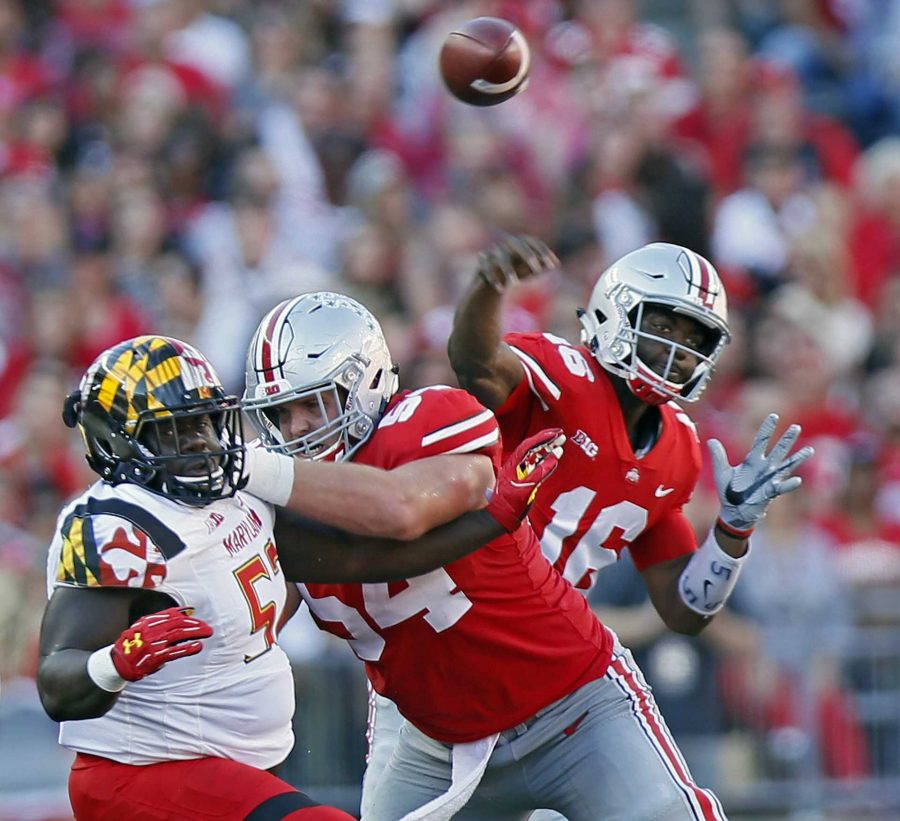By Adam Hensley
[email protected]
In theory, the best approach to taking down Ohio State is as follows: Stop Heisman-hopeful quarterback J.T. Barrett.
“Great quarterback,” senior linebacker Josey Jewell said. “He can do a bunch of different things. He can sling it, and he can also run it — another dual-threat guy.”
Barrett is on a tear through eight games, completing passes at a 69 percent clip while throwing for 2,155 yards, 25 touchdowns, and only 1 interception. On the ground, he’s piled up 465 yards and 5 touchdowns.
Posing a threat in both the passing and running attack, Iowa’s defense players need to focus in on staying in their lanes and not biting on potential fakes, Jewell said.
“You just got to be fundamentally sound up front, be able to have everybody gap-sound, be able to take their gaps away,” he said. “And have everybody rally to the ball, so if he breaks pocket, we’re going to have to run. Also, the guys in back can stay in coverage, but also the guys who don’t have a man in coverage can go run to the ball.”
Barrett’s ability to gouge defenses in numerous aspects draws similarities to Penn State quarterback Trace McSorley. Against the Hawkeyes on Sept. 23, he threw for 284 yards and a touchdown. He also ran for 61 yards — a modest outing, but he did complete 31 passes.
It’s not just Barrett, though, who can hurt Iowa.
The Buckeyes possess an aggressive receiving corps, junior defensive back Josh Jackson said.
“Just looking at them, I think they’re really aggressive and physical, so we have to be physical and aggressive back as well,” he said. “I think it’ll be a fun challenge.”
RELATED: Big Ten Media Days: Highlights from Ohio State HC Urban Meyer
The entire Ohio State offense is a well-oiled, fine-tuned machine. The Buckeyes’ rushing attack averages 245.8 yards per game, running for almost 6 yards per carry. As a team, Ohio State averages 571.3 yards of offense per game (to compare, Iowa averages 345.3 yards).
Four out of the top five rushers on Ohio State average 5.3 or more yards per carry, giving the Buckeyes a balanced offensive attack capable of scoring quickly or supporting long, methodical drives.
Keeping Barrett and Ohio State’s offense contained will be a major focus for the Hawkeye defense, but Iowa’s offense is also a pivotal factor.
The saying goes, the best offense is a good defense, but that phrase is reversible — the offense needs to step up if the Hawkeyes want a change at an upset.
“We [need] to help the defense out, keep [our defense] off the field” running back Akrum Wadley said. “We know they’re going to go balls-out. Keeping [Ohio State’s offense] off the field. We got to sustain drives.”
The Hawkeyes are barely winning the time of possession margin against their opponents so far this season, holding a 30:10 to 29:50 advantage.
Looking at when Iowa played Penn State (its best opponent so far and closest in strength to Ohio State), the Hawkeyes held the ball for 20:21, a major shortage compared with Penn State’s 39:39 time of possession.
Iowa’s offense isn’t up-tempo, at least traditionally. Three-and-outs won’t cut it against the No. 6 Buckeyes.
“We just got to stick to what we do best,” Wadley said. We got to make it a fistfight.”



